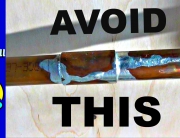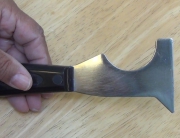September 4, 2014
How to Install Baseboard Moulding With Tight Corners
Here’s the thing about installing baseboard moulding: When you’re running baseboard, especially if it is an ornate style, it can be challenging to make the inside corners fit precisely. Even if you measure accurately and cut very carefully, seldom will you get a tight fit. There is a simple reason for this, and that is that rooms where corners meet are seldom perfectly square. Houses settle, floors are uneven, or sometimes the drywall or plaster isn’t perfectly flush, and as a result, you have an imperfect corner. So, what can you do about it? How can you get a perfect inside corner like a pro?
Well, there is a woodworking technique called coping, and this guarantees tight fitting corners every time. In a coped joint, one side is cut square, and rests in the corner, while the other piece is shaped to fit the contour of the first piece. Coping your corners is especially important if you plan on staining your baseboards, rather than painting them. With a painted baseboard, it is possible to simply miter cut two pieces of stock at a 45 degree angle, bring the two together to form a 90 degree corners and use caulking to fill and disguise a not-so-perfect cut. Once painted, it will appear to be a tight fit. However, when installing wood that you plan on leaving natural or staining, a miter cut at 45 degrees will broadcast its inadequacies, and this is when coping your inside corners is an ideal remedy.
Watch this video to learn how!







Thank you for your wonderful videos. Your coping baseboards is great for inside corners.. Is there a good way to do outside corners. I have tried 45 degree cuts with my compound miter saw and they just don’t look that great. I have tried laying my saw to the left and leaving my table set to 0 degrees. The back of the baseboards line up good but not the external corner that you actually see.. I have tried swiveling my table to 45 degrees left and then right, but the baseboard I am using is rather large.. It is 5 1/2 ” tall. I have a 12″ swivel compound miter saw. It seem awkward when I try to stand up the baseboard against the fence and make a vertical cut down through the 5 1/2 ” of baseboard. Any tips would be greatly appreciated. My wife wants me to hire out, so it looks good. Please help! Sincerely, Keith Wright
Hi Keith – you have great timing. We are working on a video now for just that task – installing baseboard on external corners. As for the issue with the height of the baseboard, I will pass your question on to Leah. Hang tight! Just wanted to let you know we saw your question, and I think we can help!
I solved a bunch of my problems by squaring up my cheap harbor freight swivel compound miter saw. The decals are way off from true 45 and 90 degrees. I still look forward to your video. Thank you so much for your assistance, Keith
Thank you for this wonderful, easy-to-follow video!! I ran out & bought a coping saw but when I got home, realized that it has types of blades (fine, medium, and coarse)…So, which blade should I use to (try to!) cope baseboards?? Again, thank you for your wonderful instructions – you would make a great teacher!!
Hi Beth,
In general, you will want to use the coarse or medium blade for most coping of molding. Look for 10 to 15 teeth-per-inch (tpi). This is because the coarser the blade, the more quickly you will remove the material, which helps with the accuracy of your cut.
The fine blades (18 or more tpi) are good for tight curves, but it will be slow-going. In most cases, the coarse or medium blade will be fine.
I enjoyed your coping video. Would coping also work on a miter saw at say 6 degrees or whatever angle you normally back cut it at or am I having another brain freeze? Im not sure I could cope that well free hand.
Did you ever finish the video on installing baseboard on external corners?
yes. It is called “How to Make Perfect Outside Baseboard Corners”. Here is the link: https://seejanedrill.com/outside-baseboard-corners/